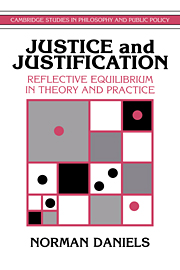Book contents
- Frontmatter
- Contents
- Preface
- 1 Introduction: Reflective equlibrium in theory and practice
- PART I
- PART II
- 9 Health-care needs and distributive justice
- 10 Equality of what: Welfare, resources, or capabilities?
- 11 Determining “medical necessity” in mental health practice, with James E. Sabin
- 12 The prudential life-span account of justice across generations
- 13 Problems with prudence
- 14 Merit and meritocracy
- 15 Rationing fairly: Programmatic considerations
- 16 Wide reflective equilibrium in practice
- Index
10 - Equality of what: Welfare, resources, or capabilities?
Published online by Cambridge University Press: 01 February 2010
- Frontmatter
- Contents
- Preface
- 1 Introduction: Reflective equlibrium in theory and practice
- PART I
- PART II
- 9 Health-care needs and distributive justice
- 10 Equality of what: Welfare, resources, or capabilities?
- 11 Determining “medical necessity” in mental health practice, with James E. Sabin
- 12 The prudential life-span account of justice across generations
- 13 Problems with prudence
- 14 Merit and meritocracy
- 15 Rationing fairly: Programmatic considerations
- 16 Wide reflective equilibrium in practice
- Index
Summary
THE TARGET OF EGALITARIAN CONCERNS
Many of us have egalitarian concerns. To some extent, that is, at some cost, we prefer a world in which goods - powers, liberties, opportunities, wealth, health - are more equally distributed to one in which they are not. At least to some extent, we are willing to forego delivering a greater benefit to someone who is already better off in order to deliver a lesser benefit to someone who is worse off. Whether we are strictly concerned with equality or merely with giving priority to the claims of those who are worse off, we face the question, What is the ultimate target of our egalitarian concerns?
Three apparently distinct targets have been proposed as answers to this question. First, when we urge specific egalitarian reforms, we are really trying to make people equally happy or satisfied, or at least to guarantee them equal opportunity for such welfare. This is the claim made by Richard Arneson and (with qualifications) by G. A. Cohen.Rejecting welfare-based targets, others say the target of our egalitarian concerns is assuring people greater equality in the resources needed to pursue their ends. Ronald Dworkin argues in this vein, and John Rawls' Difference Principle gives priority to those who are worse off according to an index of primary social goods. A third view is that the target of our egalitarian concerns is the positive freedom or capability of people to do or be what they choose. Amartya Sen rejects both welfareand resource-based accounts in favor of this target.
- Type
- Chapter
- Information
- Justice and JustificationReflective Equilibrium in Theory and Practice, pp. 208 - 231Publisher: Cambridge University PressPrint publication year: 1996



